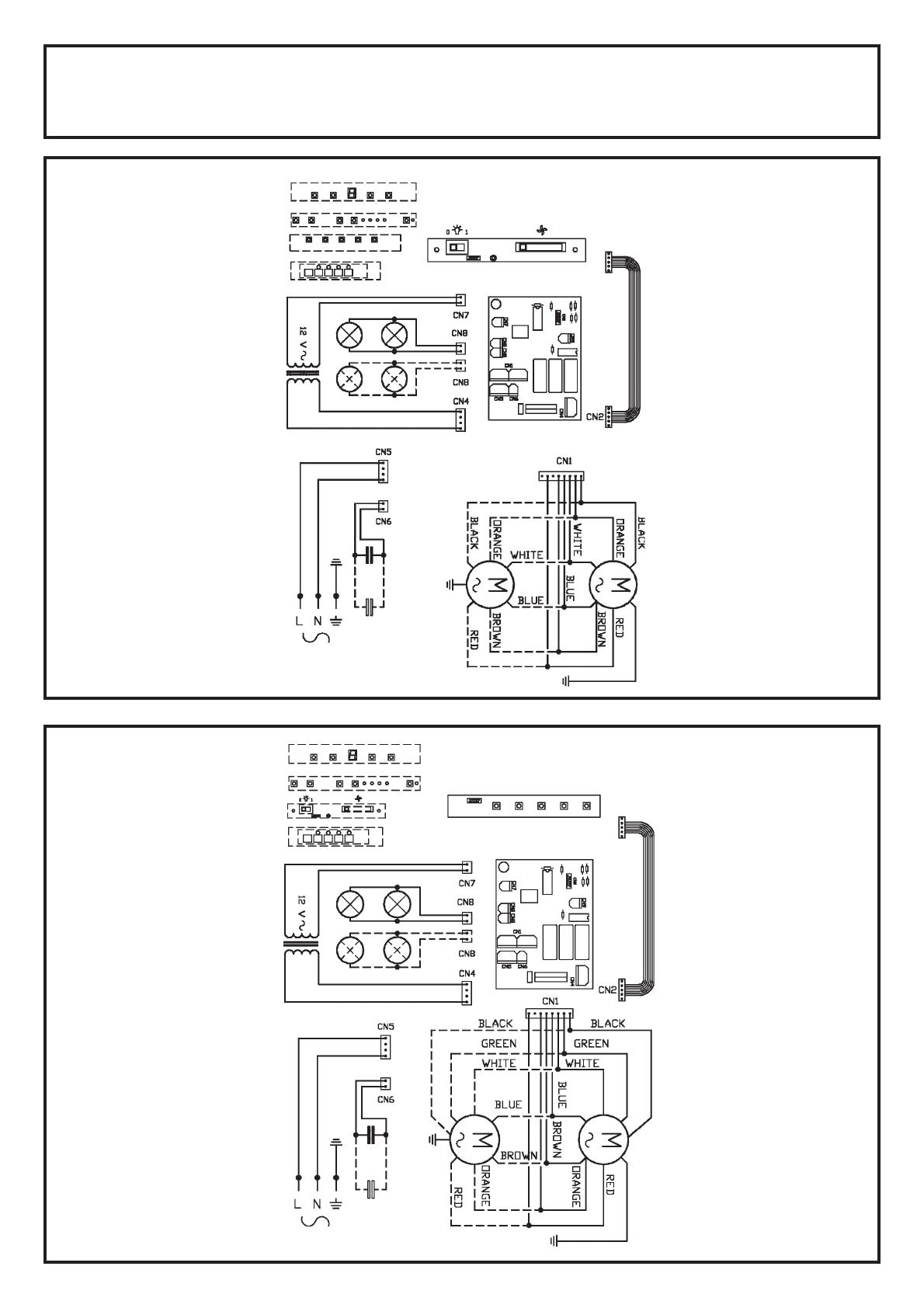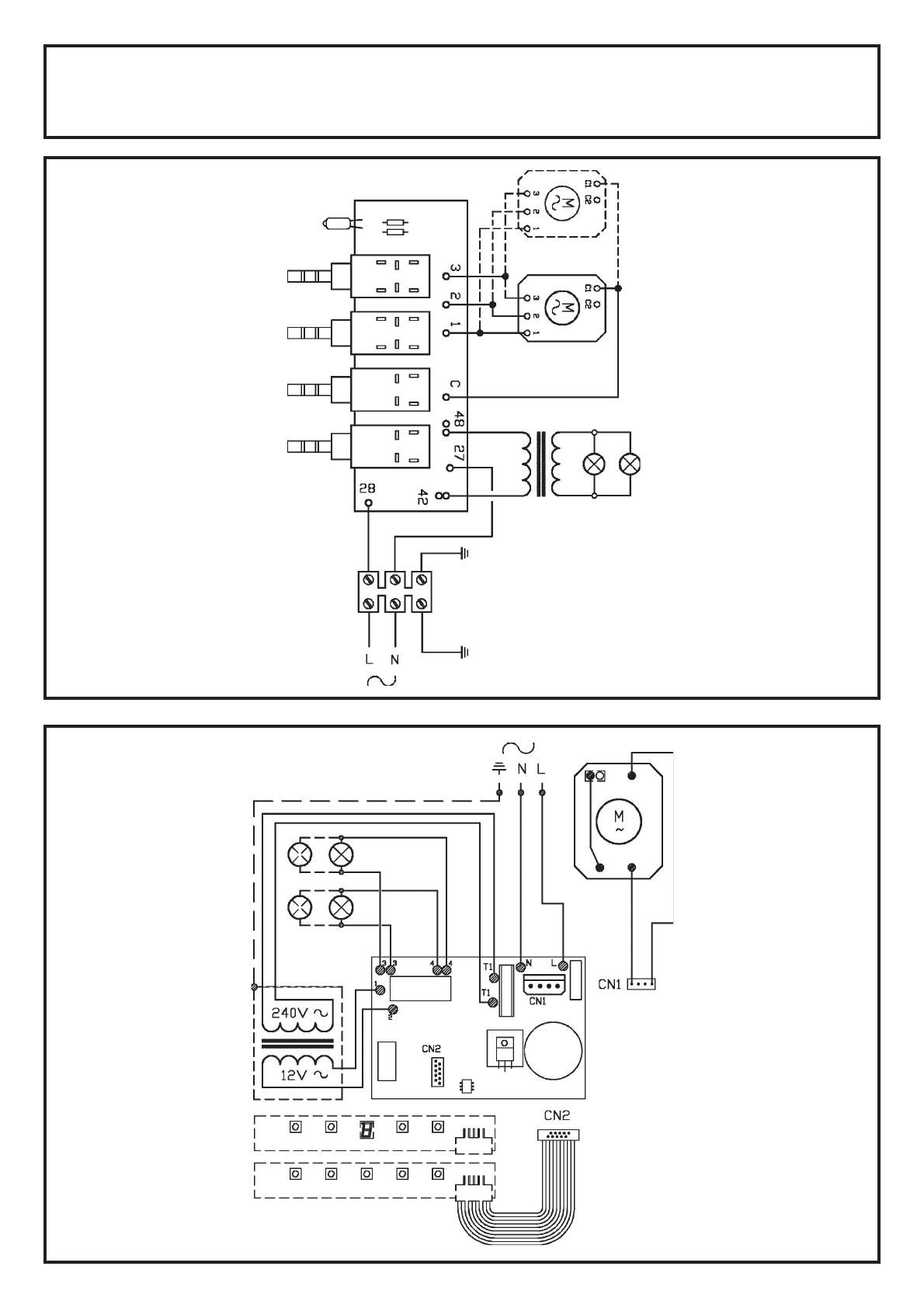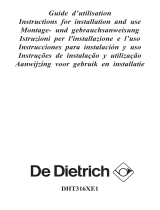Page is loading ...

Guide d’utilisation
Instructions for installation and use
Montage- und gebrauchsanweisung
Istruzioni per l'installazione e l’uso
Instrucciones para instalación y uso
Instruções de instalação y utilização
Aanwijzing voor gebruik en installatie
DHG316XP - DHG356XP
DHG376XP - DHG377XP - DHG386XP

IMPORTANT; BEFORE ANY OPERATION OF INSTALLATION AND USE, TAKE NOTE OF THE
FOLLOWING INSTRUCTIONS:
The distance between the supporting surface for the cooking vessels on the hob and the lower part of the hood must be at least 65
cm. If the instructions for installation for the hob specify a greater distance, this has to be taken into account.
The air collected must not be conveyed into a duct used to blow off smokes from appliances fed with an energy other than electricity
(central heating systems, thermosiphons, water-heaters, etc.).
Comply with the official instructions provided by the competent authorities in merit when installing the disposal duct. In addition,
exhaust air should not be discharged into a wall cavity, unless the cavity is designed for that purpose.
The room must be well aerated in case a hood and some other heat equipment fed with an energy other than electricity (gas, oil,
coal heaters, etc) operate at the same time.
In fact the intake hood, disposing of air, could create a vacuum in the room. The vacuum should not exceed 0,04mbar. This prevents
the gas exhausted by the heat source from being intaken again. It is therefore advisable to ensure the room contains air taps able
to ensure a steady flow of fresh air.
Check the data label inside the appliance; if the symbol (
) is printed, read the following: this appliance has such technical
particulars that it belongs to class II insulation, therefore it must not be earthed.
The following warning is valid in the United Kingdom only: in case your cable is not furnished with a plug, read the following
instructions; as the colours of the wires in the mains lead of this appliance may not correspond with the coloured markings identifying
the terminals in your plug, proceed as follows: – the wire which is coloured blue must be connected to the terminal which is marked
with the letter N or coloured black; – the wire which is coloured brown must be connected to the terminal which is marked with the
letter L or coloured red. – terminal of a three-pin plug.
Check the data label inside the appliance; if the symbol (
) is NOT printed, read the following: ATTENTION: This appliance must
be earthed. When making the electrical connections, check that the current socket has a ground connection.
The following warning is valid in the United Kingdom only: in case your cable is not furnished with a plug, read the following
instructions; as the colours of the wires in the mains lead of this appliance may not correspond with the coloured markings identifying
the terminals in your plug, proceed as follows: – the wire which is coloured green and yellow must be connected to the terminal in
the plug which is marked with the letter E or by the earth symbol [
], or coloured green or green and yellow; – the wire which is
coloured blue must be connected to the terminal which is marked with the letter N or coloured black; – the wire which is coloured
brown must be connected to the terminal which is marked with the letter L or coloured red.
When making the electrical connections, check that the voltage values correspond to those indicated on the data plate inside the
appliance itself. In case your appliance is not furnished with a non separating flexible cable and has no plug, or has not got any other
device ensuring omnipolar disconnection from the electricity main, with a contact opening distance of at least 3 mm, such separating
device ensuring disconnection from the main must be included in the fixed installation. If your unit features a power lead and plug,
position this so the plug is accessible.
Always switch off the electricity supply before carrying out any cleaning or servicing operations on the appliance.
ATTENTION: This appliance must be grounded.
USE
Avoid using materials which could cause spurts of flame (flambées) near the appliance.
When frying, take particular care to prevent oil and grease from catching fire. Already used oil is especially dangerous in this respect.
Do not use uncovered electric grates.
To avoid possible risks of fire always comply with the indicated instructions when cleaning anti-grease filters and when removing
grease deposits from the appliance.
MAINTENANCE
Thorough servicing guarantees correct and long-lasting operation.
Any fat deposits should be removed from the appliance periodically depending on amount of use (at least every 2 months). Avoid
using abrasive or corrosive products. To clean painted appliances on the outside, use a cloth dipped in lukewarm water and neutral
detergent. To clean steel, copper or brass appliances on the outside, it is always best to use specific products, following the
instructions on the products themselves. To clean the inside of the appliance, use a cloth (or brush) dipped in denatured ethyl
alcohol.
ENGLISH

DESCRIPTION OF THE APPLIANCE
The description and characteristics shown in this document are for information only and not obligatory. Indeed, we reserve the
right to carry out any modification or improvement of the quality of certain of our products without prior notice. .
As with all hoods, these apparatuses can be installed in either filtering version or duction version.
In the Filtering version (Fig. 1), the air and vapours conveyed by the appliance are depurated by charcoal filter and recirculated
around the room. ATTENTION: Using the hood as a filtering one it is necessary to use the charcoal filters that purifies the air sent
back into the room.
In the Ducting version (Fig. 2), cooking vapours and odours are conveyed straight outside by a disposal duct which passes
through the wall/ceiling. Use of charcoal filters is therefore unnecessary.
Decide at the beginning which type of installation to adopt.
Your apparatus is supplied in the filtering version so that if you want to install the apparatus in the duction version you must remove
the carbon filters.
This apparatus conforms to the 16.08.89 regulation relating to the limitation of radio-electric disturbances (EC Directive n./6.889
modified by the EC Directive 8/.308.).
INSTALLATION
It is advisable to entrust the installation operations to specialised personnel.
Installation in filtering version
To facilitate installation, before starting remove the grease filter/s: press inward on the clamp at the handle and pull the
filter downward (Fig. 3).
Cut a hole in the bottom of the pensile cupboard in order to settle the appliance (Fig. 4).
Install the wiring system.
Insert the appliance in the hole (Fig. 4)
Tighten the 2 screws inside the appliance (Fig. 5) until it fits snug on the bottom of the wall unit. Avoid tightening the two screws
with excessive force.
To the air venting flange of the apparatus connect a proper pipe that can convey the air to the upper part of the pensile cupboard.
Make the electrical connection of the hood by means of the power supply cable.
Fig. 1
Fig. 2
Fig. 3a
Fig. 4
Fig. 3b
MODELS A
DHG386XP
DHG316XP
DHG356XP
DHG376XP
DHG377XP
677.5mm
497mm

Installation in ducting version
Cut a hole in the bottom of the pensile cupboard in order to settle the appliance (Fig.4).
Install the wiring system and prepare the air venting hole.
Insert the appliance in the hole (Fig. 4)
Tighten the 2 screws inside the appliance (Fig. 5) until it fits snug on the bottom of the wall unit. Avoid tightening the two screws
with excessive force.
To get optimal conditions the air venting pipe should: be as short as possible, have the lowest number of bends (max bende angle:
90°), be made of material approved by local authorities (according to the State), have its inner side as regular and smooth as
possible. It is moreover recommended to avoid drastic changes of pipe cross section (recommended diameter: 150 mm).
L’apparecchio è dotato di una riduzione 150-125cm.
Using a proper pipe, connect the air venting flange of the apparatus to the air venting hole you made beforehand.
Make the electrical connection of the hood by means of the power supply cable.
FUNCTIONING OF THE APPARATUS
Depending on the model, the unit is equipped with the following controls:
DHG356XP, DHG376XP, DHG377XP, DHG386XP
CONTROLS - Fig. 6:
A - Light ON/OFF switch
B -Motor ON/OFF - I speed switch
C -II speed switch - Pressing once more the timer starts working: it will turn the motor OFF after a 10’ working time:
the led blinks for all this time
D -III speed switch - The timer works as for switch C
E -IV speed switch - The timer works as for switch C.
At the end of a working time of about 30 hours, all the leds blink all together to tell that the grease filters must be cleaned. After
the cleaned filters are on again, press one of the three speed switches to allow the counting to start again.
DHG316XP
CONTROLS - Fig. 7:
A - Light ON/OFF switch
B -Motor ON/OFF - I speed switch
C - II speed switch
D -III speed switch
E - motor on light.
Fig. 5
Fig. 6
Fig. 7

Technical data - DHG316XP:
- 1 Motor - power 135W
- Voltage: 230-240V single phase
- 2 halogen lamps 20W
- Supplied with 150 cm electricity supply cable with plug.
- Gross weight: Kg.8,4
- Net weight: Kg.6,9
- 1 metallic grease filter
Technical data - DHG376XP:
- 1 Motor - power 300W
- Voltage: 230-240V single phase
- 2 halogen lamps 20W
- Supplied with 150 cm electricity supply cable with plug.
- Gross weight: Kg.10,4
- Net weight: Kg.8,9
- 1 metallic grease filter
Technical data - DHG386XP:
- 1 Motor - power 300W
- Voltage: 230-240V single phase
- 2 halogen lamps 20W
- Supplied with 150 cm electricity supply cable with plug.
- Gross weight: Kg.8,2
- Net weight: Kg.7,2
- 2 metallic grease filters
Dimensions (Fig. 8)
ELECTRICITY CONNECTION
While connecting the electricity make sure that the tension is that indicated in the technical lable.
Before proceeding to cleaning or maintenance operations remove the tension.
Connecting the electricity must be performed by a specialised technician in conformity with the regulation in force.
This apparatus is constructed so as to belong to the I insulation class and therefore needs grounding.
Technical data - DHG356XP:
- 1 Motor - power 155W
- Voltage: 230-240V single phase
- 2 halogen lamps 20W
- Supplied with 150 cm electricity supply cable with plug.
- Gross weight: Kg.8,4
- Net weight: Kg.6,9
- 1 metallic grease filter
Technical data - DHG377XP:
- 1 Motor - power 300W
- Voltage: 230-240V single phase
- 2 halogen lamps 20W
- Supplied with 150 cm electricity supply cable with plug.
- Gross weight: Kg.10,5
- Net weight: Kg.9,5
- 2 metallic grease filters
Fig. 8
DHG356XP
DHG376XP
DHG377XP
DHG386XP
DHG316XP

MAINTENANCE
REMOVE THE TENSION AT THE HOOD (PLUG or SWITCH) BEFORE ANY OPERATION-
Thorough servicing guarantees correct and long-lasting operation.
-Maintenance of the casing:
Avoid products containing abrasives when cleaning the casing.
-Maintenance of the anti-grease filters:
The anti-grease filters require regular maintenance and must be cleaned periodically every two months.
Remove the anti-grease filters in correspondence with the handle, push the stop inward and pull the filter downwards (Fig.9).
Wash them with a normal neutral product in commerce, then rinse abundantly and dry. The washing can be carried out in the
dishwasher making sure not to let the filters make contact with dirty or silver dishes.
Remount the anti-grease filters.
-Maintenance of the carbon filters:
If you are using the filtering version apparatus, the carbon filters (Ref.: DHK306AP1) need to be changed every six months on
average depending on the use made of the hood.
The anti-grease filters (Fig. 9a, 9b) need to be removed first in order to remove the carbon filters. Remove the two metal filter
retainers (M) and position the charcoal filter inside the grease filter; fit the two filter retainers back on again to secure the
charcoal filter (Fig.10). Change the carbon filters and remount the anti-grease filters.
-Changing the halogen lamps:
To change the halogen bulbs open the cover levering from the proper slots (Fig.11). Change with a lamp of the same kind.
CAUTION: Do not handle glass bulb with bare hands.
Fig. 9a
Fig. 9b
Fig. 10
Fig. 11

SCHÉMA ÉLECTRIQUE - WIRING DIAGRAM - ELEKTRISCHER SCHALTPLAN
SCHEMA ELETTRICO - ESQUEMA ELÉCTRICO - ESQUEMA ELÉCTRICO
ELEKTRISCH SCHEMA
DHG386XP
DHG376XP
DHG377XP

DHG316XP
DHG356XP
SCHÉMA ÉLECTRIQUE - WIRING DIAGRAM - ELEKTRISCHER SCHALTPLAN
SCHEMA ELETTRICO - ESQUEMA ELÉCTRICO - ESQUEMA ELÉCTRICO
ELEKTRISCH SCHEMA

04307150/1
Nous restons à votre disposition pour tout renseignemant complémentaire, à cette fin:
Vous pouvez nous contacter :
SERVICE CONSOMMATEURS DE DIETRICH
BP 9526 - 95069 CERGY PONTOISE CEDEX
Vous pouvez nous consulter :
36.15 DE DIETRICH*
*(1,29 F la minute)
(demande de catalogue - conseils pratiques - adresses diverses - suggestions).
Vous pouvez aussi nous téléphoner :
LE SERVICE APRÈS-VENTE DE DIETRICH
Un seul numéro pour toute la France
N° Azur 0 801 63 25 25
Relations consommateurs
36.15
Service Après-Vente
Tout dépannage doit être effectué par un technicien qualifié.
Seul les distributeurs de notre marque :
Connaissent parfaitement votre appareil et son fonctionnement.
Appliquent intégralement nos méthodes de réglage, d’entretien et de réparation.
Utilisent exclusivement les pièces d’origine.
Pour toute demande à votre distributeur, précisez-lui la référence complète de votre appareil (type de l’appareil et numéro de
série)
Ces renseignements figurent sur la plaque signalétique fixée à l’interieur de l’appareil.
Les descriptions et les caractéristiques apportées dans ce livret sont données seulement à titre d’information et non d’engagement.
En effet, soucieux de la qualité de nos produits, nous nous réservons le droit d’effectuer, sans préavis, toutes modifications ou
améliorations nécessaires.
PIÈCES D’ORIGINE : demandez à votre vendeur que, lors d’une intervention
d’entretien, seules des PIÈCES DÉTACHÉES CERTIFIÉES D’ORIGINE soient utilisées.
/

